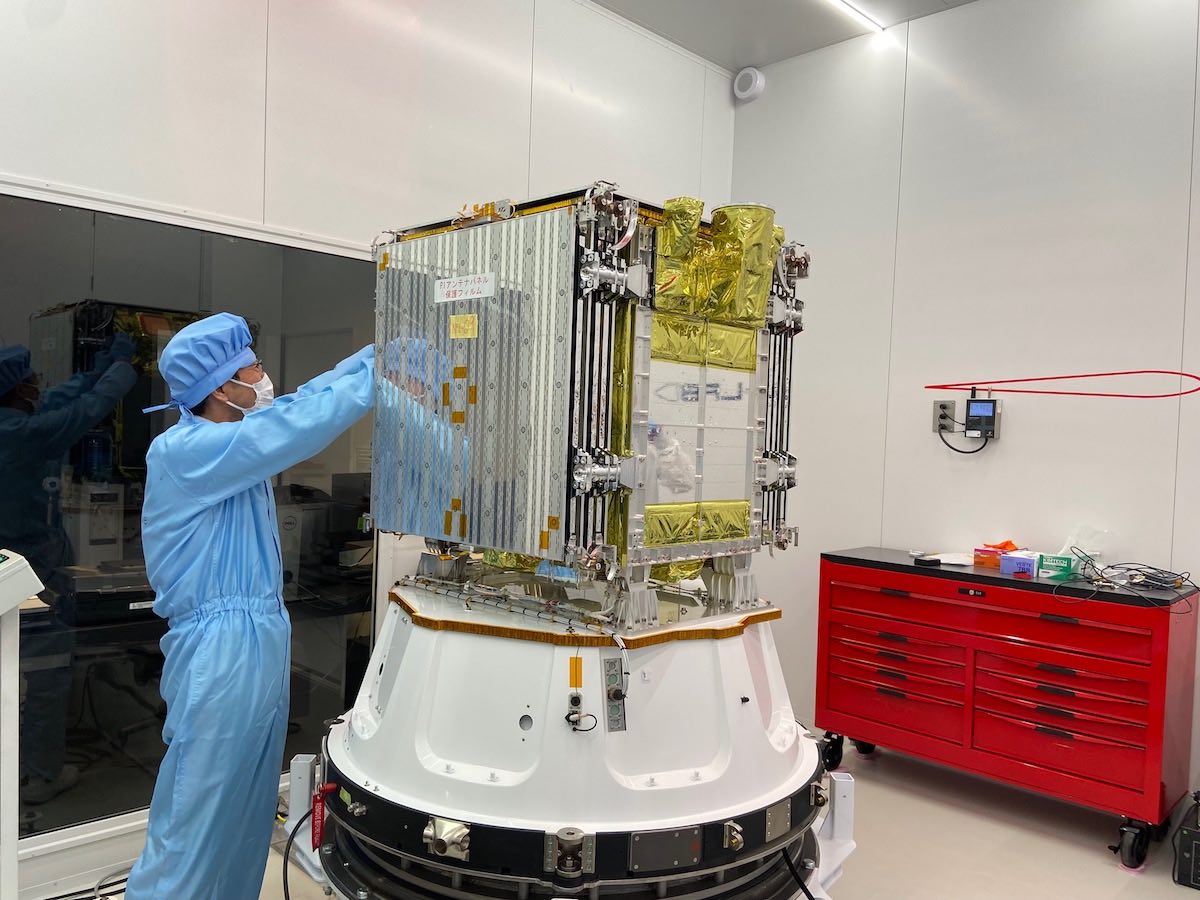
Rocket Lab’s 30th mission delivered the StriX 1 radar imaging satellite into orbit for the Japanese Earth observation company Synspective, beginning the deployment of a constellation of 30 commercial radar satellites planned over the next four years.
Riding a two-stage Electron launcher, the Japanese radar payload took off from Rocket Lab’s privately-owned spaceport on Mahia Peninsula, located on the North Island of New Zealand. Liftoff occurred at 4:38 p.m. EDT (2038 GMT) Thursday, or 8:38 a.m. local time in New Zealand on Friday.
Nine Rutherford main engines powered the 60-foot-tall (18-meter) Electron rocket into the sky with more than 50,000 pounds of thrust. The launcher headed south from Rocket Lab’s spaceport, targeting a polar sun-synchronous orbit.
The first stage’s Rutherford engines shut down about two-and-a-half minutes into the mission, then the booster stage separated to fall into the Pacific Ocean. A single Rutherford engine on the rocket’s second stage ignited for a nearly seven-minute firing to reach a preliminary parking orbit. The rocket jettisoned its payload shroud and spent batteries during the second stage burn.
A kick stage separated from the Electron second stage, coasted over Antarctica, then fired about 50 minutes after liftoff for a burn to circularize its orbit at an altitude of around 350 miles (563 kilometers). Rocket Lab confirmed the StriX 1 radar remote sensing satellite deployed from the kick stage around 54 minutes into the mission.
The mission, nicknamed “The Owl Spreads Its Wings” by Rocket Lab, was the company’s seventh Electron launch of the year, and the 30th Electron flight overall since 2017. The StriX 1 satellite was the 150th spacecraft delivered into orbit by Rocket Lab, which specializes in launches of small satellites and has started development of a larger reusable rocket called the Neutron.
StriX 1 is the first commercial satellite for Synspective, a Japanese startup company planning a fleet of 30 radar imaging spacecraft. The launch of StriX 1 follows the launch of two demonstration satellites on Rocket Lab missions in 2022 and in February of this year.
Synspective’s fleet of satellites will provide high-frequency, high-resolution images worldwide. Radar imaging satellites can resolve Earth’s surface in darkness and through clouds, giving Synspective and other companies with similar constellations an all-weather observing capability. StriX 1, like the two predecessor demonstration satellites, weighs around 200 pounds (100 kilograms), according to Synspective.
StriX 1’s deployable X-band radar antenna, measuring 16 feet (5 meters) across once unfurled, can see features on Earth’s surface as small as 3 feet, or 1 meter.
The antenna and the satellite’s solar arrays were stowed for launch to fit inside the Electron rocket’s payload fairing. Rocket Lab designed a custom design payload shroud to accommodate Synspective’s cube-shaped satellites, which comes close to the limit of Electron’s payload capacity.
The mission launching StriX 1 was the second launch in a bulk buy of three Rocket Lab flights.
“From launching Synspective’s first demonstration spacecraft to now helping to build their SAR (synthetic aperture radar) constellation with this launch of their first commercial StriX satellite, it’s an honor to once again be the trusted launch partner for Synspective,” said Peter Beck, Rocket Lab’s founder and CEO. “As the sole payload on this dedicated Electron launch, Synspective are able to build their constellation to a specific LTAN (local time of the ascending node) that couldn’t be achieved if StriX was launched on a rideshare mission with other satellites — a highly important differentiator when building a new satellite constellation.”
Synspective is one of numerous commercial companies developing remote sensing satellite constellations. The company says its radar satellites will provide near-real time imagery to help customers respond to natural disasters, survey natural resources, track urban activity, and monitor ship traffic, among other applications.
“Unlike the previous two satellites, which are classified as demonstration satellites, StriX 1 is our first pre-commercial satellite for full-scale business expansion,” Synspective said. “This is in anticipation of the production and operation of multiple satellites in the future, with improved batteries and faster downlink speeds to capture more data and meet the needs of a wide range of customers from government to the private sector.”

Synspective said it will launch three more satellites after StriX 1 by the end of 2023. The company aims to have its full constellation of 30 satellites orbit by 2026.
Rocket Lab did not attempt recover the Electron booster stage on the StriX 1 mission, but engineers continue to make progress in testing to prepare for future recoveries, and eventually the reuse, of first stage boosters.
Engineers recently test-fired one of the nine Rutherford main engines from an Electron booster recovered from a launch in May. That mission was the first time Rocket Lab caught a descending booster under parachute with a helicopter. The aircraft released the rocket for a soft splashdown in the Pacific Ocean, and Rocket Lab raised the booster from the sea for return to New Zealand.
Rocket Lab plans to try again to catch an Electron booster after a launch later this year.
Email the author.
Follow Stephen Clark on Twitter: @StephenClark1.
from Spaceflight Now https://ift.tt/U07Zp1r
via World Space Info







0 comments:
Post a Comment